Rajneesh Gupta [Rajneesh Gupta] - Hands-On Cybersecurity with Blockchain
Here you can read online Rajneesh Gupta [Rajneesh Gupta] - Hands-On Cybersecurity with Blockchain full text of the book (entire story) in english for free. Download pdf and epub, get meaning, cover and reviews about this ebook. year: 2018, publisher: Packt Publishing, genre: Home and family. Description of the work, (preface) as well as reviews are available. Best literature library LitArk.com created for fans of good reading and offers a wide selection of genres:
Romance novel
Science fiction
Adventure
Detective
Science
History
Home and family
Prose
Art
Politics
Computer
Non-fiction
Religion
Business
Children
Humor
Choose a favorite category and find really read worthwhile books. Enjoy immersion in the world of imagination, feel the emotions of the characters or learn something new for yourself, make an fascinating discovery.
- Book:Hands-On Cybersecurity with Blockchain
- Author:
- Publisher:Packt Publishing
- Genre:
- Year:2018
- Rating:4 / 5
- Favourites:Add to favourites
- Your mark:
Hands-On Cybersecurity with Blockchain: summary, description and annotation
We offer to read an annotation, description, summary or preface (depends on what the author of the book "Hands-On Cybersecurity with Blockchain" wrote himself). If you haven't found the necessary information about the book — write in the comments, we will try to find it.
Develop blockchain application with step-by-step instructions, working example and helpful recommendations
About This Book- Understanding the blockchain technology from the cybersecurity perspective
- Developing cyber security solutions with Ethereum blockchain technology
- Understanding real-world deployment of blockchain based applications
The book is targeted towards security professionals, or any stakeholder dealing with cybersecurity who wants to understand the next-level of securing infrastructure using Blockchain. Basic understanding of Blockchain can be an added advantage.
What You Will Learn- Understand the cyberthreat landscape
- Learn about Ethereum and Hyperledger Blockchain
- Program Blockchain solutions
- Build Blockchain-based apps for 2FA, and DDoS protection
- Develop Blockchain-based PKI solutions and apps for storing DNS entries
- Challenges and the future of cybersecurity and Blockchain
Blockchain technology is being welcomed as one of the most revolutionary and impactful innovations of today. Blockchain technology was first identified in the worlds most popular digital currency, Bitcoin, but has now changed the outlook of several organizations and empowered them to use it even for storage and transfer of value.
This book will start by introducing you to the common cyberthreat landscape and common attacks such as malware, phishing, insider threats, and DDoS. The next set of chapters will help you to understand the workings of Blockchain technology, Ethereum and Hyperledger architecture and how they fit into the cybersecurity ecosystem. These chapters will also help you to write your first distributed application on Ethereum Blockchain and the Hyperledger Fabric framework. Later, you will learn about the security triad and its adaptation with Blockchain. The last set of chapters will take you through the core concepts of cybersecurity, such as DDoS protection, PKI-based identity, 2FA, and DNS security. You will learn how Blockchain plays a crucial role in transforming cybersecurity solutions.
Toward the end of the book, you will also encounter some real-world deployment examples of Blockchain in security cases, and also understand the short-term challenges and future of cybersecurity with Blockchain.
Style and approachThis book will follow a practical approach to help understand blockchain technology to transform cybersecurity solutions
Downloading the example code for this book You can download the example code files for all Packt books you have purchased from your account at http://www.PacktPub.com. If you purchased this book elsewhere, you can visit http://www.PacktPub.com/support and register to have the files e-mailed directly to you.
Rajneesh Gupta [Rajneesh Gupta]: author's other books
Who wrote Hands-On Cybersecurity with Blockchain? Find out the surname, the name of the author of the book and a list of all author's works by series.

![Rajneesh Gupta [Rajneesh Gupta] Hands-On Cybersecurity with Blockchain](/uploads/posts/book/119697/thumbs/rajneesh-gupta-rajneesh-gupta-hands-on.jpg)









